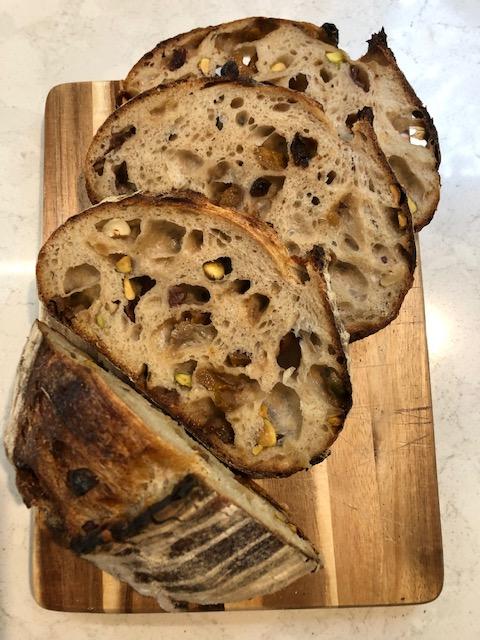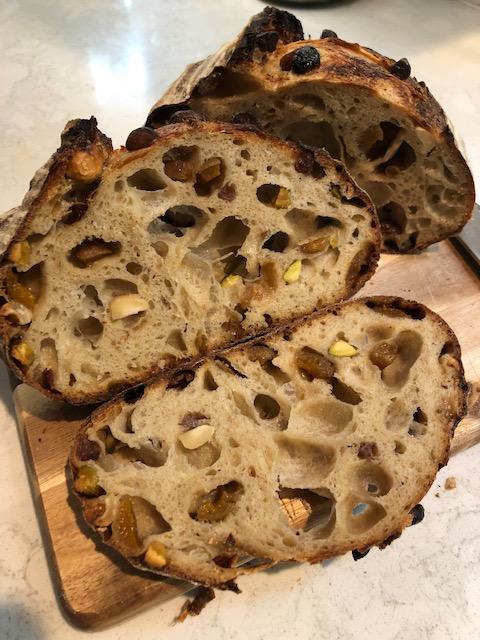
Harvest Loaf
With the cooler weather I was tempted to experiment a bit with adding some dried fruit and nuts to my basic everyday sourdough loaf (with the addition of some honey). If it turned out well, I planned on upping the whole wheat percentage on a subsequent bake (next week maybe).
I should have let the hydrated fruit and nuts dry out a tad longer because I think they added some mini 'steam zones' within the crumb, resulting in some large holes. However, instead of pulling moisture from the dough, they adding some to the crumb and I was super pleased with the resulting springy, custard-like texture. The flavor is great as well. I initially was going to use just dried apricots and pistachios but decided to add some dried cranberries and hazelnuts too, soaking the lot in some boiling water for a couple hours before adding them (drained) during lamination.
I can't tell if the dough was slightly over-fermented or if the irregular crumb was due to the increased moisture from the hydrated fruit/nut mixture. Since this is my first time using such a large 'add in' (the family likes pretty plain bread here unfortunately) I don't really have anything to judge by. On the plus side, this loaf is all mine ;-). I buzzed through half a loaf at frightening speed...had to slice the rest and put it in the freezer before I hurt myself.
Any comments from those bakers more versed on fruited/nut loaves would be greatly appreciated, including any info on better methods related to treatment of those add ins (like, how long is best for soaking as well as drying, when best to add to the dough, etc). Cheers!





Comments
I’ve been adding dried fruits and nuts for many years. The best way I have found is not to soak at all. My method works perfectly without the over- hydration that occurs when soaking. Mist the dried fruit with water, liqueur or fruit juice cover and place in the microwave for 30 sec toss lightly and check and repeat if necessary. I have reconstituted fruit that was rock hard using this method and it always works. A great side effect is you don’t lose any flavor to the excess water that occurs with the boiling water soak even if you use that soaker water the fruit suffers. Also for added flavor toss the warm fruit with cinnamon/ sugar or other spice it makes delicious pockets of goodness.
As for nuts pre roasting them adds great flavor- dry roast on lowest setting in a skillet use a simmer plate to prevent too much heat. Stop roasting as soon as nuts are fragrant . Amazing flavor. Do not soak… never any reason to hydrate nuts.
Your bread looks wonderful! c
Hey TR! Thanks so much for the reply. The tips are very much appreciated. I was under the assumption (apparently incorrectly ;-) ), after reading several recipes here on TFL and the web, that I needed to rehydrate the fruit, and I usually do the same boiled water technique for my seeded loaf, to soften the millet, flax and other seeds. But, what you noted was definitely true about the loss of flavor regarding the fruit...it was not quite as bold as I was hoping for. I also wondered about using some cinnamon but have read it can impede yeast and rise, but it sounds like this is not an issue for your bakes--very glad you mentioned this as well. Definitely agree with you on the roasting step for the nuts...it makes a huge difference on flavor. I really appreciate you taking the time to provide some VERY helpful information and can't wait to put these new tips into practice!
The misting is rehydrating the fruit it doesn't take as much moisture as you might think. Also if you do it right before you add the fruit to the dough while it is just warm it helps with the rise as well. I never have problems with adding cinnamon to. my dough but I like it coating the dried fruit as it does add a lovely burst of flavor with each bite. Your loaf is really beautiful and I love the crumb so I wouldn't worry. I am always glad to help. Baked my first loaves in the mid 70's and have never looked back . Bakers helping bakers. c
Lovely loaf and lovely choice of inclusions.
What I have noticed in my own baking is that it helps to pat down the inclusions when laminating, to even push them into the dough, and also to pat down each layer after folding up the lamination, with the aim being to avoid trapping of air pockets.
I still get some cavitation, which is normal, I guess, but it seems to reduce it quite a bit.
-Jon
Thank you, Jon! Your tip makes a lot of sense, to make sure there is more contact with the dough and to reduce the air pockets/cavitation. I did a series of coil folds after the lamination, which I think helped distribute the add-ins better, but it might not have done as much to really get that good contact with the dough. I will definitely incorporate this great tip into my next attempt! Thanks again!
Leigh, I’m sure that was a delicious loaf of bread. I would say that it is a tad underproofed since you were asking. I do like to soak my dried fruit in something that will enhance the flavour and often will do a soak in liqueur of some sort. I also do that because I have bottles of liqueurs that we’ve been given over the years that would never otherwise to used LOL.
Benny
Soaking the dried fruit in liqueur sounds delightful...I might have to incorporate that into something for the holidays. I may have to get another small bottle of Grand Marnier just for that purpose! Thank you, too, for the comment on the fermentation. I was thinking it was slightly over-proofed given some of the larger holes, but I couldn't tell if that was more from the excess steam produced from the fruit or not. Really, it was more about how it felt when I was shaping (it barely held together) but I didn't really communicate that well in my description. My 2nd attempt (on a subsequent post) seemed to feel more within the 'sweet spot' during shaping but was definitely a little tighter during S&Fs, so much so that I was really worried about it having any rise at all. Well, the experimentation continues ;-). Thanks for the tip and comments!